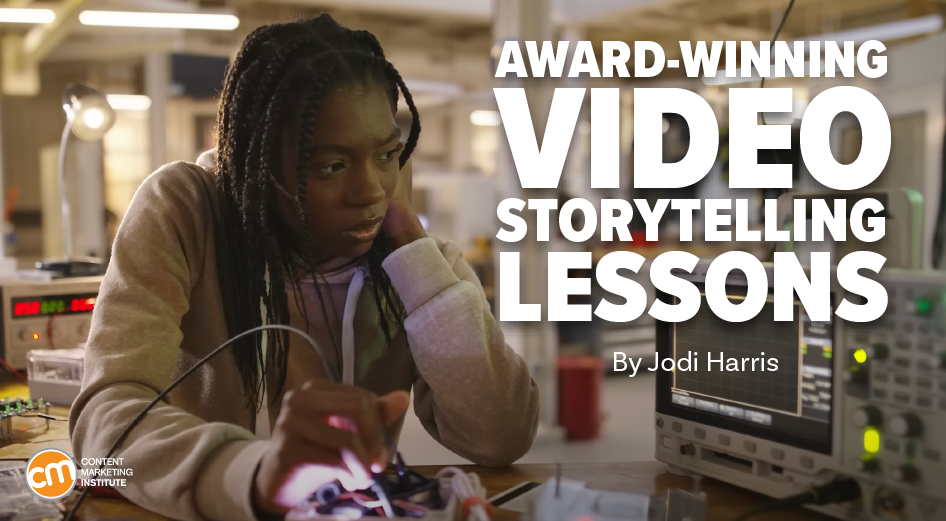MARKETING
Award-Winning Video Storytelling Lessons | Content Marketing Institute

Few shared experiences possess the emotional resonance and universal relatability as the one embodied by this question: “What do you want to be when you grow up?”
It served as a tentpole for Purdue University’s student recruitment marketing through a video that illustrates one ambitious person’s vision of their journey – with Purdue playing a pivotal role at every step.
The video achieved notable success against the institution’s marketing goals. It also won the 2023 Content Marketing Award for Best Motivational Video/Video series and was named a Project of the Year finalist.
What do you want to be when you grow up? The ubiquitous question inspired @LifeAtPurdue to create an award-winning video via @Joderama @CMIContent. Click To Tweet
Let’s explore the vision behind this visual content hit and how it contributed to impressive marketing results for the brand.
What Can You Imagine at Purdue?
The video – What Can You Imagine at Purdue? – captures the essence of the university’s message: “The only barriers to what you can achieve should be the limits of your imagination.”
In the video, a young Black girl wonders aloud about what she’s going to do when she grows up. As her father braids her hair, he replies, “Whatever you can imagine.” Then, he covers her eyes and asks what she sees for her life.
Viewers glimpse her desired future and all the milestones she’ll reach along the way. The visuals and voiceover relate to the story of her dreams of building robots at Purdue Polytechnic High School, going to Purdue University, and exploring her passions through extracurricular activities and on-campus communities.
She relates her vision to that of her father, who’s earning his degree at Purdue Global (the institution’s online university for working adults). At the end of the video, this proud father asks his daughter what she’ll do from there. Her answer: “Whatever I want.”
4 lessons on video content marketing success
Purdue’s video storytelling teaches important lessons – ones your brand can follow on its path to marketing success.
Align content with core brand values
In an interview with the Content Marketing Institute, R. Ethan Braden, Purdue’s executive vice president and chief marketing and communications officer, says his team crafted the story around core tenets of Purdue’s brand essence – ‘persistent innovation together’.
- Persistent: The central character works on a challenging project in a Purdue classroom. Her father asks what she’ll do if she doesn’t succeed at first. Her answer: “I’ll try again, and again, and again …” That message is reinforced as viewers see her troubleshoot her experiment and, ultimately, make a breakthrough.
- Innovation: The girl mentions career possibilities in rocket science and computer science. That emphasizes Purdue’s curricula in those fields of study while modeling available opportunities for women who want to pursue career education in science, technology, engineering, and mathematics.
- Together: Purdue sees success as achieved through collaborative – not competitive – efforts. This concept is reinforced through the girl’s vision of meeting other students on campus, making memories with friends, and enjoying time with her peers in the Purdue student community.
@LifeAtPurdue crafted its No. 1 video message around the brand’s core tenets – persistent innovation together, says @REthanBraden via @Joderama @CMIContent. Click To Tweet
A clip showing the girl’s father logging into an online portal to receive his assignments as a student at Purdue Global connects the story to the brand’s commitment to making higher education accessible to all, including adults furthering their education while remaining in the workforce.
Purdue’s video smartly communicates how offerings like Purdue Global make higher education more universally attainable, regardless of their stage of life, economic circumstances, or scheduling needs.
It’s also worth noting that the video features a Black family, given the systemic disadvantages experienced by people of color that may affect their vision of college. “We wanted to tell that story with asset framing, through that lens of a little African American girl and her father, and we wanted to really get it right,” Ethan says.
Enchant your audience with emotive storytelling
Ethan says enchanting Purdue’s target audiences is his team’s sole goal for content creation. “It’s to rouse them and attract their ecstatic admiration and demand for Purdue, whatever that means in that moment.”
The video achieves this with its relatable theme of dreaming of the future. Emotive experiences reinforce that message – a father helping his daughter prepare for school and a student exploring her passions and building friendships.
Ethan notes those details inspired viewers to comment: “You know when he’s braiding her hair? I teared up because that was authentic,” and “I’ve never heard of Purdue before, and now I wanna go there.”
This evidence indicates his team hit on the right emotions and insights to expand audience awareness, interest, and consideration of Purdue.
Through a terrific product and content efforts like this, Ethan says Purdue has seen a 30% increase in its student body over 10 years, and applications have doubled in the last five years.
Applications to @LifeAtPurdue doubled in the last five years thanks in part to its inspiring and motivational #ContentMarketing, says @REthanBraden via @Joderama @CMIContent. Click To Tweet
Show how your experiences connect
Brands need a clear content marketing strategy to guide their customers through all the stages of their buyer’s journey. Purdue’s video takes viewers through an aspiring student’s personal journey – one that highlights the Purdue portfolio of offerings and the institution’s various pre-college, online, and extracurricular offerings.
The Purdue team deliberately emphasized how its experiences connect under a broad portfolio of educational products. Ethan says this distinguishes Purdue’s content from standard university marketing focusing on a single institution.
“We wanted you to see her go to high school. We wanted you to see her aim for Purdue,” Ethan says. “We wanted you to see her father going to Purdue Global and achieving his degree as a working adult, and how those [experiences] stitched together [as part of the] Purdue portfolio.”
Expand reach with multiplatform distribution
According to Purdue, the video earned more than 28 million views on YouTube, with an astounding 82% view rate. In just 28 days, it became the most-viewed video on the Purdue YouTube channel, besting a video that had earned views for over 15 years.
Those are impressive results for any video asset, let alone a two-minute ad. But Purdue didn’t rely on organic reach alone. The ad gained a big promotional boost in critical visibility moments like the Macy’s Thanksgiving Day Parade, the Big 10 championship football game, and the Citrus Bowl.
Ethan says the campaign also involved posts on social media (where it earned 170,000 views and more than 670,000 impressions) and was promoted through award entries, including the Content Marketing Awards.
The team also invests in socializing its content internally to ensure their organizational stakeholders understand and appreciate the value of content. “We prioritize marketing the marketing so others can see the excellence and expertise of this team and their contributions,” says Ethan, which gives them the buy-in they need to do their jobs to the best of their abilities.
See increased video success in your brand’s future
Purdue’s video ad captured and kept its target audience’s attention. It also ensured more viewers would see the breadth of what Purdue has to offer. So, what can your videos be when they grow up? Let Purdue’s four lessons help you manifest that vision.
MORE EXAMPLES FROM 2023 PROJECT OF THE YEAR FINALISTS
Cover image by Joseph Kalinowski/Content Marketing Institute
MARKETING
A Recap of Everything Marketers & Advertisers Need to Know

When rumors started swirling about Twitter changing its name to X, I couldn’t believe it at first. But then, in July 2023, as I searched for my favorite blue icon on the phone, I found a black icon instead. It had actually happened!
MARKETING
The key to correcting the C-suite trust deficit

Take a moment to search “CMO tenure” and you’ll find a wide variety of content discussing the short tenure of CMOs and how it’s among the shortest of roles in the C-suite. If you dive deeper, you’ll find that CEOs don’t seem to trust CMOs.
Boathouse’s CMO Insights study (registration required) noted several sobering conclusions:
- 34% of CEOs have great confidence in their CMOs.
- 32% of CEOs trust their CMOs.
- 56% of CEOs believe their CMO supports their long-term vision.
- And only 10% of CEOs believe their CMO puts the CEO’s needs before their own.
If these statistics also apply to the CMO’s entire organization, then it’s clear we have a trust problem with marketing leadership.
If you haven’t read Patrick Lencioni’s “The Five Dysfunctions of a Team,” I consider it required reading for anyone in any leadership role. In his book, Lencioni builds a pyramid of dysfunctions that need to be addressed for a team to succeed. The foundational dysfunction — with which one cannot build a successful team — is “absence of trust.” We see it at scale with marketing organizations today.
Introducing objectivity through data
In “Hamlet,” Shakespeare writes, “There is nothing either good or bad, but thinking makes it so.” Each organization that makes up a company looks at the company from a different perspective. What marketing sees as positive, finance may see as negative. But who’s right? No one.
Usually, there is no objectivity because leadership comes up with an idea and we execute it. It’s like the fashion proverb “Beauty is in the eye of the beholder.” Unfortunately, we’re going to struggle to run a profitable organization if it’s run like a fashion show.
Therefore, we need to introduce objectivity to how we work. Leadership needs to come together to agree on goals that align with the goals of the broader organization. One element of this conversation should be an acknowledgment that this is turning a ship.
Often leaders — especially those without marketing backgrounds — are likely to expect instant gratification. It’s going to take time to turn the ship and you and your team would do well to set reasonable expectations right away.
Dig deeper: KPIs that connect: 5 metrics for marketing, sales and product alignment
Aligning goals and metrics across the organization
With goals in hand, we need to assign metrics to their progress and agree on the source(s) of truth. Once these objective measures are in place, perspective doesn’t matter. 2 + 2 = 4 regardless of whether you’re in HR or accounting.
Every public road has a speed limit and whether you’re in compliance with it has nothing to do with your perspective. If you’re above it, you’re wrong and subject to penalties. Referring to the fashion example, it’s not a fashion show where some people like a dress and others don’t.
By using data to objectively measure marketing’s progress within the organization and having the rest of the leadership buy into the strategy, we build trust through objectivity. Maybe the CEO would not have chosen the campaign the marketing team chose.
But if it was agreed that a >1 ROAS is how we measure a successful campaign, it can’t be argued that the campaign was unsuccessful if the ROAS was >1. In this example, the campaign was an objective success even if the CEO’s subjective opinion was negative.
Data-driven campaign planning
Within the marketing organization, campaigns should always be developed with measurement top of mind. Through analysis, we can determine what channels, creative, audiences and tactics will be most successful for a given campaign.
Being able to tell the leadership team that campaigns are chosen based on their ability to deliver measured results across metrics aligned to cross-departmental goals is a powerful message. It further builds trust and confidence that marketing isn’t run based on the CMO’s subjective opinions or gut decisions. Rather, it’s a collaborative, data-driven process.
For this to be successful, though, it can’t just be for show, where we make a gut decision and direct an analyst to go find data to back up our approach. This would be analytics theater, which is a perversion of the data. Instead, tell the analyst what you think you want to do and ask them to assess it.
For the rest of the organization’s leadership, ask questions when the marketing team presents a campaign. Find out how they came up with the strategy and expect to hear a lot about data — especially the metrics you all agreed would support the company’s overarching goals.
Dig deeper: 5 failure points of a marketing measurement plan — and how to fix them
Data literacy: Building credibility through transparency
Building trust doesn’t happen overnight, but a sustained practice of using data to drive marketing leadership’s decisions will build trust if the metrics ladder up to the organizational goals and all of leadership is bought into the measurement plan.
Over time, this trust will translate into longer tenure and more successful teams through building the infrastructure needed to tackle Lencioni’s five dysfunctions.
Opinions expressed in this article are those of the guest author and not necessarily MarTech. Staff authors are listed here.
MARKETING
How Tagging Strategies Transform Marketing Campaigns


As a marketer, I understand how today’s marketing campaigns face fierce competition. With so much content and ads competing for eyeballs, creating campaigns that stand out is no easy task.
That’s where strategies like tagging come in.
It helps you categorize and optimize your marketing efforts. It also helps your campaigns cut through the noise and reach the right audience.
To help you out, I’ve compiled nine ways brands use a tagging strategy to create an impactful marketing campaign.
Let’s get to it.
How Brands Use a Tagging Strategy
Tagging involves using keywords or labels to categorize and organize content, products, or customer data. You attach tags to specific items or information to make searching, sorting, and analyzing data easier.
There are various types of tags, including meta tags, analytics tags, image tags, hashtags, blog tags, and more.
So, how do brands use a tagging strategy to make their marketing campaigns stand out?
Improve Social Media Engagement
With over 5 billion users, social media provides an easy way to connect with your audience, build relationships, and promote your offerings.


Use a tagging strategy to boost social media interactions. Consistently use hashtags that align with current trends and topics. This encourages people to interact with your content and boosts content visibility.
You can also use tags to monitor brand mentions of your products or your industry. This allows you to engage with your audience promptly.
Consider virtual social media assistants to streamline your tagging strategy. These AI-driven tools can suggest relevant hashtags, track mentions, and automate responses. Implementing them can save time and resources while ensuring consistent engagement across your socials.
Build a Personal Brand on LinkedIn
LinkedIn is the world’s largest professional networking platform, with over 1 billion members across 200 nations. It offers excellent opportunities for individuals and businesses to build and nurture their brands.


However, simply creating a professional profile isn’t enough to build a personal brand on LinkedIn.
Use various tags to increase your visibility, establish thought leadership, showcase expertise, and attract the right connections. For instance, use skill tags to showcase your expertise and industry tags to attract connections and opportunities within your industry. Use certification tags to help showcase your expertise and credibility to potential employers or clients.
Facilitate Customer Segmentation and Personalization
Personalization matters—more so in today’s data-driven world. In fact, 65% of consumers expect your brand to adapt to their changing preferences and needs.
To meet this expectation, consider using a tagging strategy.
Segment your customers based on shared characteristics, such as demographics, interests, purchase history, cart abandonment, and behavior.
Here’s a summary of the steps to customer segmentation.


With your customer segments ready, use tags to tailor your marketing messages and offerings to specific segments. Imagine sending targeted email campaigns based on what your customers need. That’s the power of segmentation and tagging in action!
Enhance SEO and Content Discoverability
Tagging content can have a profound impact on search engine optimization (SEO) and content discoverability. When users search for specific topics or products, well-tagged content is more likely to appear in search results, driving organic traffic to your website.
Additionally, tags can help you analyze the most popular topics with your readers. Then, the results of this analysis can help you adjust your content strategies accordingly.
And get this— certain AI tools can help analyze your content and suggest relevant tags and keywords. Using these tools in addition to a tagging strategy can help optimize your SEO strategies and boost content discoverability.
Partner with the Right Influencers
Influencer marketing has become a go-to marketing approach for modern brands. Recent stats show that 85% of marketers and business owners believe influencer marketing is an effective marketing strategy.
But how do you find the perfect influencer for your campaign?
Utilize tags to identify influencers who are relevant to your niche. Beyond this, find influencers who align with your brand values and target audience.
Additionally, look for influencers who use hashtags that are relevant to your campaigns. For instance, fashion influencer Chiara Ferragni uses #adv (advertising) and #ghd (good hair day) hashtags in this campaign.


Monitor industry-specific hashtags and mentions to discover influential voices and build profitable relationships with them.
Track Hashtag Performance
Tracking your hashtag performance helps you understand your campaigns’ engagement, reach, and effectiveness.
To achieve this goal, assign special hashtags to each marketing project. This helps you see which hashtags generate the most engagement and reach, enabling you to refine your tagging strategy.
Here’s an example of a hashtag performance report for the #SuperBowl2024.


This curated list of hashtag generators by Attrock discusses the top tools for your consideration. You can analyze each and choose the one that best fits your needs.
Categorize Content Accordingly
The human attention span is shrinking. The last thing you want is for your audience to have difficulty in finding or navigating your content, get frustrated, and bounce.


Untagged content can be difficult to navigate and manage. As any marketer knows, content is important in digital marketing campaigns.
To categorize your content, identify the main categories by topics, themes, campaigns, target audiences, or product lines. Then, assign relevant tags based on the categories you’ve identified. After that, implement a consistent tagging strategy for existing and new content.
Organizing your content using tags can also help streamline your content management workflow. Most importantly, readers can easily find the content they’re looking for, thereby boosting overall user experience, engagement, and conversions.
Boost Your Email Marketing Strategy
Email marketing remains a powerful marketing tool in today’s digital world. It’s also another area where brands use a tagging strategy to directly reach their target audience.
Use tags to segment your email list and personalize your marketing messages. Then, you can send targeted emails based on factors like purchase history, interests, and demographics.
Personalization can significantly improve open rates, CTRs, and overall engagement and conversion rates. It’s a simple yet impactful strategy to make your email marketing strategy more effective.
Plus, you can use tags to track how well your emails perform with each group. This helps you understand what content resonates best with your audience and provides insight on how to improve your emails going forward.
Enhance Analytics and Reporting
Every marketer appreciates the immense value of data. For brands using tagging strategies, tags are powerful tools for gathering valuable data.
Analyze how users interact with your tagged content. See which tags generate the most clicks, shares, conversions, and other forms of engagement. Gain insight into audience preferences and campaign effectiveness.
This granular data about your marketing efforts allow you to make data-driven decisions, allocate resources effectively, and refine your marketing strategies.
Final Thoughts
There isn’t a single correct way for brands to use a tagging strategy in marketing. You can use a tagging strategy however you see fit. However, the bottom line is that this strategy offers you a simple yet powerful way to create attention-grabbing and unique marketing campaigns.
Fortunately, tagging strategies are useful across various marketing initiatives, from social media and email marketing to SEO and more.
So, if you’re ready to elevate your marketing campaign, build a strong brand presence, and stand out among the competition, consider employing effective tagging strategies today.
-
SEARCHENGINES7 days ago
Daily Search Forum Recap: April 29, 2024
-
SEARCHENGINES6 days ago
Daily Search Forum Recap: April 30, 2024
-

 MARKETING6 days ago
MARKETING6 days agoHow To Develop a Great Creative Brief and Get On-Target Content
-

 SEO7 days ago
SEO7 days agoGoogle’s John Mueller On Website Recovery After Core Updates
-

 WORDPRESS6 days ago
WORDPRESS6 days ago13 Best Fun WordPress Plugins You’re Missing Out On
-

 SEO5 days ago
SEO5 days agoWhy Big Companies Make Bad Content
-

 SEO5 days ago
SEO5 days agoHow To Drive Pipeline With A Silo-Free Strategy
-

 SEO6 days ago
SEO6 days agoOpenAI To Show Content & Links In Response To Queries
















